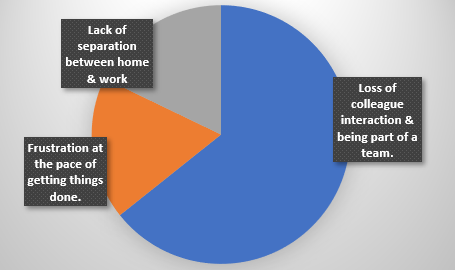Recalibrating The Demand For Remote Working
8th May 2020
Will employees still want to work from home after the pandemic? How perspectives have changed.
Millions of workers have been forced into mandatory home working. For most, it is a new experience as less than 30% of the workforce have ever worked from home before.
Working from home has been a sought-after employee benefit for years, and we're realising the practical advantages right now, spending less (none) of our salary on travel costs or using time spent commuting on other things.
But our view of the attractiveness of remote working is being coloured by the crisis. In lockdown there is very little flexibility, high levels of anxiety and home schooling to cope with too. While business leaders may gain a new appreciation that remote working is practical for their organisation, employees have also had the opportunity to discover that it may not be living up to their expectations. In fact, 60% of the people we asked said it was now less attractive to them than before the crisis.
There's also a greater appreciation of what home working means, one respondent summed it up:
I've worked from home for years. The interesting thing for me has been that more people relate to it now, which has strangely made for closer relationships with work colleagues (I'm no longer the odd one).
What are people missing the most?

The vast majority miss the interaction with colleagues. Despite access to collaborative tools, there's no substitute for face to face communication when building new client relationships; getting everyone's input during meetings and feeling part of a team. For others, the pace of getting work completed is frustrating either through lack of infrastructure, internet speed, the ability to self-motivate when alone or because of household distractions. And separating work from home life is difficult for others, with a blurring of boundaries.
While continual remote working is less attractive, this experience has reinforced the appeal of working remotely on a more flexible basis. Taking what we've learned over the last few weeks it is possible to introduce long term flexible work practices much more successfully.
Personality and Behaviours
It makes sense that some jobs are better suited to homeworking than others – where proximity to people or operations is required then it is going to be much tougher to make it work well.
While certain jobs don't naturally lend themselves, we need to acknowledge that as individuals, there's a relationship between personality and successful home working too. Research by Thomas International shows that three key traits for more successful home working are Conscientiousness, Adjustment and Curiosity.
Personality is also very important when determining how to manage remote workers, how to ensure their voice is heard in team work and determine the frequency and communication methods they need to stay engaged and productive.
To discover if remote working really is for you, try it, for a trial period.
Processes and Support
Optimise processes and ensure employees have the equipment and technical support they need to do their jobs effectively – thinking about everything from the comfort of their office chair, the supply of stationery, connectivity to company services and cloud software solutions.
Business processes may work very well when people are together, in the same place, but are they fit for purpose for remote workers or is the lack of continuity counter-productive? Introducing collaborative tools such as SharePoint, Microsoft Teams and Zoom is great, but they'll only be used if employees know how to use them and understands the purpose of each one.
This is also an opportunity for business meetings to become more effective, forcing shorter, more action driven discussions compared to the death by discussion meetings so often held in an office.
Trust and Flexibility
This is a biggie for many employers - how productive the employee will be while working from home. This may take a change in attitude in your business to make it work, moving away from micro-managing and KPIs to setting very clear outcomes as the benchmark for individual success.
Mutual agreement to a remote working policy is required so that everyone understands the basis of the working arrangement. But one of the things that makes remote working so attractive, is the ability to devise your own working day around your personal circumstances. Have a personal appointment at 11 am for an hour? Need to do the school run at 3.30pm? Prefer working between 7 – 9pm?
You can see how it requires trust and communication to make it work, with your outputs actually determining how productive you are, not the number of hours you spend sitting in front of the PC. Transparency is required too and that's where sharing a schedule comes to the fore.
Structure and Schedule
This might seem contradictory to trust and flexibility, but it's not, it is absolutely complementary. To make home working as successful as it can be, we encourage a designated space, preferably behind a door which can be firmly closed at the end of the working day. Not only is this important from an IT and data security point of view but it is also really important for mental wellbeing, facilitating the ability to "switch off".
Try to recreate your normal working day schedule at home, particularly if you need the input of others. Initially, this will allow you to determine how much more (or less!) you get done at home, but it is also important for the rest of the team to know when you are available.
As everyone becomes accustomed to remote working you can start to design your day, in a way that makes you most productive – just detail everything in a shared calendar including scheduling non-work time; regular tasks and events; meetings and "do not disturb I'm really concentrating" time.










